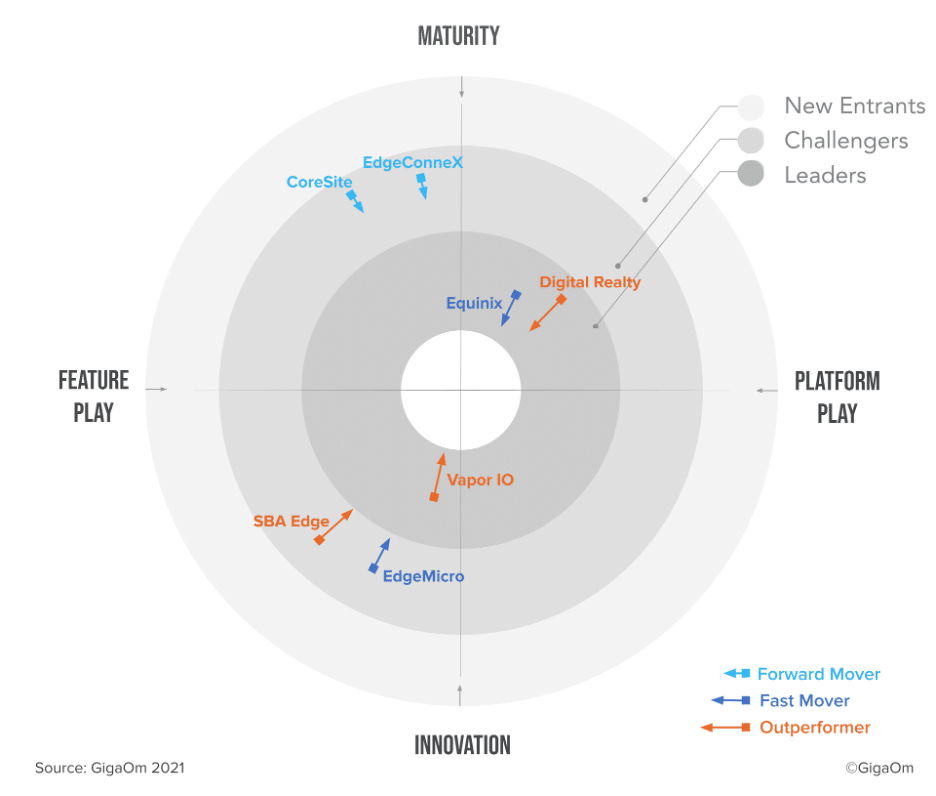Network operators risk drifting away from their competitive advantages, pulled by the tides of change in the industry driven by 5G, mergers and new entrants. Without anchoring themselves at the edge, telcos risk being disrupted by the next generation of applications.
It has become more difficult than ever to navigate the changing landscape of mobile telecommunications. Today’s telecom industry experiences continuous change. Old and new OTT services, new competitive entrants, changing user habits, and other disruptors, such as 5G and CBRS, place billions of dollars of infrastructure investment at risk. There is, however, a low-risk path forward.
By anchoring themselves to Vapor IO’s Kinetic Edge, network operators can economically deploy next-generation technologies and partake in the business models they enable.
For network operators, the Kinetic Edge represents a platform for continued success in the years to come as the industry continues to evolve and progress from a need for human-centric performance and scale targets to those that are suited for billions of connected autonomous devices, enabling city-scale IoT applications.
Anchored at the Edge
Infrastructure edge computing, as manifested in the Kinetic Edge nationwide network of edge data centers, shouldn’t be seen as competing with other investments by the network operator, such as those capital expenditures to support 5G, SDN or NFV; the Kinetic Edge is shared infrastructure that becomes the economical (low CAPEX) foundation upon which the network operator can build those capabilities. The Kinetic Edge provides edge infrastructure to meet the operator’s investment and technology goals without requiring them to build out an extensive network of edge data centers and supporting network topologies.
Micro data centers deployed at the operator side of the last mile network provide large pools of general-purpose compute, network and data storage resources with the elastic resourcing of the centralized cloud at physical locations as close as possible to their end users, be they people or devices. This model is infrastructure edge computing, which the Kinetic Edge has brought to life.
These factors make Kinetic Edge data centers the ideal locations to operate Virtualized Network Functions (VNFs), to provide peering, Internet Exchange (IX) functions or interconnection, and also to operate demanding next and current-generation applications for cost and performance such as content distribution, real-time autonomous vehicle control and web SaaS applications.
Lost at Sea
There are three key challenges facing many modern network operators today, and it can be difficult to know where to start addressing each of them. The Kinetic Edge makes this choice a lot easier by providing a flexible, performant and economical anchor for three key challenges:
1. SDN and NFV
In many cases, the existing network infrastructure that network operators rely on today is based on the use of fixed-function hardware appliances. Devices such as switches, routers and dense firewalls provide many vital network functions, but represent significant amounts of inflexible investment which cannot be easily repurposed to respond to the changing needs of the network operator, driven by changes in the behavior of their users and the services which they are using.
Software Defined Networking (SDN) and Network Functions Virtualization (NFV) abstract many of these network functions and perform them in software on general-purpose compute hardware which allows the network operator to adapt their network infrastructure in real-time to developing needs. New service chains, where one network function feeds into several others to provide a specific service to users or the network operator themselves, can therefore be achieved rapidly.
At the Kinetic Edge, our unique combination of SDN-driven network interconnection and dense colocation enables the network operator to perform key network functions for their own networks using SDN and NFV, in a cost and time-effective way by utilizing our SDN-based infrastructure.
2. Disaggregation
There is plenty of commentary and development in the industry around the last mile, that final segment of the operator network which connects to its end users. Less visible to the majority of us is the middle mile, the segment of network infrastructure that connects the last mile to the centralized aggregation locations dispersed across a network operator’s network. In many cases, even if a piece of data is sent to a device in the same room as its sender, it must go through the entire middle mile infrastructure before taking a hairpin turn back to where it came from. This entire journey may span a state, or in some cases, even greater distances first.
Disaggregation seeks to break this centralized model apart, distributing the network functions that are currently centralized such as peering, interconnection or Internet Exchange (IX) to the edges of the network. Not only does this improve performance, which is vital to achieving the target latency figures of many next-generation applications, it also spares the network operator from the need to continually invest at a high level in legacy middle mile network infrastructure once significant amounts of traffic are able to bypass these circuitous paths and take a more direct route to their intended destinations. Disaggregation is a significant network evolution.
At the Kinetic Edge, each of our edge data center sites can function as a disaggregated network node which provides peering, interconnection of IX functions at the network edge. This changes the topology of the network for the network operator, who can now rely on using cost-effective shared infrastructure to perform these functions in place of expensive, dedicated aggregation.
3. 5G and densification
5G ushers in a number of changes to cellular networks, with perhaps none being discussed more than the 5G NR-based Radio Access Network (RAN). This, however, is only part of the story when it comes to deploying 5G; these networks are intended to support a wide range of use cases and users through adaptability and logical separation with techniques like network slicing, as well as the use of shorter-range radio cells than many current-generation macrocells. This combination of Virtualized Network Functions (VNFs) and the need for ultra low latency to support many of the 5G target use cases such as autonomous vehicles and next-generation public safety leads to the use of general-purpose compute resource at the edge of the network.
Although 5G may be making most of the headlines in the industry today, it is clear that existing 4G LTE networks will see continual investment for many years to come. Part of this investment is driven by the need for greater network densification, where a higher number of smaller radio cells are used to cover a given area and number of users than they are in many areas today. In these cases, large numbers of small cells can be backhauled via local fiber connectivity to an infrastructure edge data center, where the VNFs that support them can then be operated from.
At the Kinetic Edge, our edge data center sites are located close to key population centers and are connected to nearby towers, macro and small, via metro mesh fiber. This combined with the advantages of NFV and SDN as described above lets the network operator perform key 5G network functions as VNFs at the edge of the network, utilizing our shared infrastructure.
What all of these trends and technologies have in common is that they are all readily supported by the Kinetic Edge enabling the network operator to simplify their investment and development.
Summary
By utilizing infrastructure edge computing, as made real by Vapor IO’s Kinetic Edge nationwide network of edge data centers, the network operator can effectively and efficiently meet their goals and address the challenges they face in network transformation in the years ahead.





